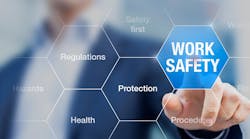The focus of the recent Campbell Institute Symposium of the National Safety Council centered around the implications of the fourth industrial revolution on safety. The label most ascribed to this era is “Cyber Physical Systems.” The driver of this revolution is technology, but the implications of it go much deeper. Changes in technology without accompanying strategic and cultural changes can cause more problems than they solve. So how do you prepare your safety efforts to meet these coming challenges?
The first step is to become more familiar with emerging technologies for safety and more generally for other purposes that may support safety efforts. New products are being developed at an incredible pace and safety professionals will find they need either more time, exposure (conferences and workshops, etc.), professional help from the IT department or even a dedicated safety technician. New digital equipment ranges from drones and robots to wearables for workers, proximity sensors for vehicles and even smart PPE. We have helped many client companies perform analyses of past accident data to prioritize the adoption of new technologies by the number and/or severity of potential accidents they could prevent. Technology products then need to be priced and budgeted over the future time periods.
The final product that should come from these efforts is a technology roadmap. Although such a plan may change due to future issues or developments, it will provide a foundation for planning other aspects of safety that must support the technology.
The roadmap will enable the expansion or redevelopment of the overall safety strategy. If the organization does not have such a strategy, then now is the time to develop one. Strategy is a methodology and plan to achieve a goal. In this case, the strategy should be the way the organization is going to identify and mitigate risks inherent in the products or services produced. Strategy is much needed in safety where all too often the efforts are a group of programs directed at lagging indicators.
In programmatic safety programs, major actions are often reactive rather than proactive. Strategy recognizes that success is more than avoiding failure, and outcomes are the result of processes and performance. The strategy aligns the processes and performance according to the strategic methodologies.
The most excellent safety strategies begin with the mindset that workers are not a problem to be controlled but rather the customers of safety efforts. The strategy should be centered around adding value to those customers to enable them to do their jobs more safely. New technology can enable the organization to move up the hierarchy of controls, eliminating employee exposure and relying less on administrative controls.
Leadership
Just as the roadmap gave clarity and enabled the strategy, the strategy should clarify and enable the development of three other elements that need to be aligned with Industry 4.0. The first of these is leadership.
Read the full article at EHS Today, which, like IndustryWeek, is powered by Informa.



